

 |
 |
|
|
|
||
|
Have
a look at the main resorts and tourist attractions of the area.
|
||
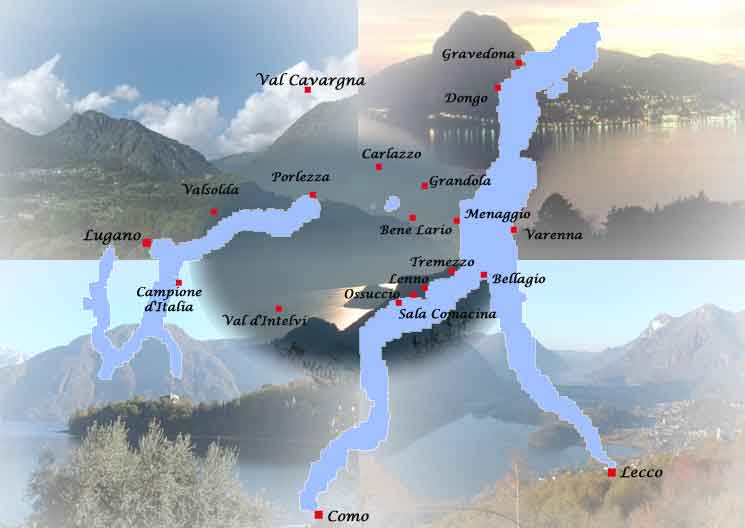 |
||
| Porlezza | 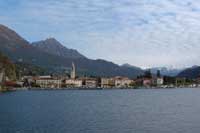 |
|
| Porlezza is one of the most famous tourist villages of the Ceresio lake. Right on the Ceresio's shores Porlezza knew a considerable development in the last few years. Alongside with its shops and hotels Porlezza is rich of medieval and baroque works bearing witness to its historical and artistic importance. Among its several monuments it is worth visiting the Romanesque oratory of St. Maurizio and the oratory of St. Maria dei miracoli (16th century). Among Porlezza's natural beauties let's not forget the caves in Rescia. | ||
| Carlazzo | 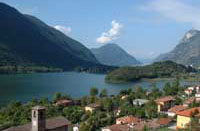 |
|
| Carlazzo, one of the biggest villages of the Porlezza-area, is rich of natural and artistic attractions (first and foremost the nature reserve of the Piano Lake). Alongside with the charming Castle that preserved its origins as a fortified medieval village throughout the centuries, it is worth visiting the church of St. Giacomo and St. Fedele rising in the centre of the village, the church of St. Giorgio in the hamlet of Gottro (famous for its Romanesque bell tower), the church of St. Stefano containing the famous organ created by Serassi (1858) and the church of St. Nazzaro and Celso. | ||
| Valsolda | 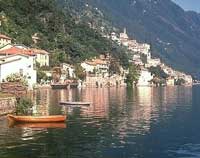 |
|
| After more then one century, the village managed to preserve the same colours and scents described in the famous novel "Piccolo Mondo Antico", written by Antonio Fogazzaro. In the hamlet of Cressogno you will find the Sanctuary of Caravina still in perfect condition (built between the 16th and 17th century); the parish church consecrated to the "Our Lady's purification" dating back to the 16th century, the frescoes painted by Carloni and still preserved in good condition. Walking down the streets of Dasio and Loggio, you will surely come across ancient coats of arms and frescoes still in excellent condition decorating the oldest dwellings. Having a relaxing stroll along the shores of the Ceresio lake, you will reach the picturesque square of San Mamete, surrounded by the arcades, where people, in the past, used to gather to take important decisions concerning the life in the village. | ||
| Val d'Intelvi | 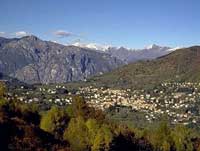 |
|
| Going up from Porlezza you will find San Fedele, the ideal point of departure to reach the other villages of the valley. The Intelvi valley is rich of historical and architectonic testimonies: the church of St. Maurizio in Casasco, where the fresco painted by B. Luini in the 16th is still preserved in good condition; the parish church of St. Antonio in San Fedele (a Romanesque building of 12th century); the one-aisle church of St. Stefano in Castiglione with its six lateral vaults. The Intelvi Valley constitutes one of the greatest attractions of the Insubria area. You cannot miss the wonderful view you can enjoy from the "Terrace of Italy " located on the top of the Sighignola mount in Lanzo d' Intelvi. It is also worth visiting the" Museum of the Valley" in Scaria. | ||
| Val Cavargna | 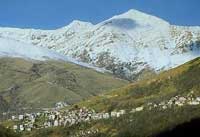 |
|
| That's the ideal place for people who like mountain hiking. Cavargna (1071 m high) is the highest village in the province of Como. In San Lucio (1500 m) you will find the mountain pass bearing the same name and connecting the Cavargna valley with the Swiss Colla valley. In the mountain hut of San Lucio, built in the 14th century, religious celebrations and local festivals take place every year on 12th July and 16th August. Tourists who would like to know everything about the Cavargna valley, cannot but visit the Val Cavargna Museum, where precious testimonies about the professions, the customs and the several historical aspects of local life are collected. | ||
| Grandola e Uniti | 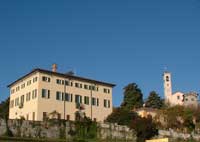 |
|
| The village, which is made up of several hamlets rising along the mountain, is the ideal place for those who like trekking, mountain biking and having romantic walks in the woods and along the narrow streets all about the village centre, where the wonderful Villa Camozzi is to be found. Here art exhibitions and various cultural events often take place. Noteworthy is also Villa Bagatti-Valsecchi. Do not miss the "Rogolone ", the secular 300-year-old oak and one of the oldest Italian trees. And last but not least do not forget to visit one of the several "Crotto's" (a small typical restaurant) where, while admiring the wonderful panorama, you will also enjoy a good lunch including typical local food and wine. | ||
| Bene Lario | 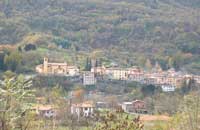 |
|
| The village of Bene Lario, rising between the left bank of the Civagno torrent and the slopes of Calbiga mount, enjoys the unique advantage of being surrounded by wonderful green woods. As part of the nature reserve of the Piano lake, Bene Lario is one of the favourite destinations for hikers from all over Europe. Alongside with the centre of this wonderful ancient village characterised by its typical cobblestone paving and its old fountains, it is worth visiting the church of The Holy Trinity and the church of St. Vito and St. Modesto and, of course, the old flour mills now in disuse. | ||
| Menaggio | 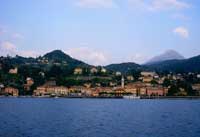 |
|
| Menaggio, placed in the middle of the western shore of Lario, is one of the oldest villages of the Como lake (Just think that the Gauls were the first to visit it!). Not only is Menaggio rich of attractions (shops, restaurants, sport centres and discos), but it also gives tourists the opportunity to go for breath-taking hikes on the mountains surrounding the village. Do not miss the mountain hut in the village of Plesio, (1400 m high): the point of departure of the difficult trekking route, known as "La ferrata", and of many other short routes like the climbing to the Monte Grona (1736m) and the hike to the Chapel of St. Amate (1623m). | ||
| Tremezzo | 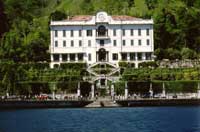 |
|
| Tremezzo, one of the favourite destinations of the European nobility at the end of the last century, has always been the catalyst for tourism in the central area of the Como lake. Throughout the years Tremezzo has managed to turn into an elegant, refined and hospitable tourist centre. Walking under the famous arcades of Tremezzo you will easily reach Villa Carlotta, one of the most beautiful attractions of the Como lake. Not only is the villa in the heart of a charming botanical garden, but it also has artistic treasures of remarkable value like the sculptures made by Canova, Acquisti and Thorvaldsen and the paintings by Appiani, Hayez, Migliara, London and Vikar. | ||
| Lenno | 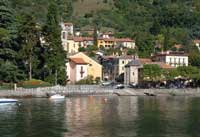 |
|
| In the past Lenno together with Tremezzo and Mezzegra was part of the famous village known as "Tremezzina": an area English writers of the last century often described in their works and one of the favourite destinations for tourists from all over the world. Lenno, an ancient village of Romanesque origin, rose on the shores of the wonderful "Golfo di Venere", extending from the cape of Avedo hill to the village of Portezza. The Romanesque Baptistery and Crypt, the church of St. Stefano (11th century), the Acquafredda abbey (12th century) and, of course, the gorgeous Villa Balbianello, maybe the most fascinating and charming historical dwelling of the Lario, are also worth visiting. | ||
| Sala Comacina | 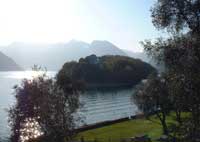 |
|
| Sala Comacina is an ancient village built on the shore opposite the only island of the Como Lake: Isola Comacina. The village is rich of archaeological finds and was the stage of epic battles making up an important part of Italian history. Every year, on the last Sunday of June, a famous religious feast, "La Sagra di San Giovanni", takes place. This is a famous traditional event, characterised by a wonderful procession of historical boats taking believers wearing ancient costumes to the island. A fantastic fireworks show takes place on the Saturday before the feast. The show represents the historical battles fought on the island in the past. | ||
| Ossuccio | 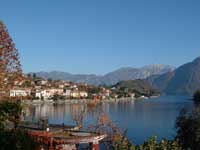 |
|
|
This small village rises just opposite the Isola Comacina (Comacina island), and extends across the slopes of the valley behind it. The Sanctuary of "La Madonna del Soccorso", the first part of which was built in 1635, constitutes one of the greatest attractions of the whole Como lake. The Sanctuary has 14 chapels built between 1663 and 1688 placed all along the sacred tree-lined avenue at the entrance. Here 230 chalk and stucco statues, made by Francesco and Agostino Silva da Morbio are to be found. Every year, on 8th September, a traditional feast celebrating the nativity of the Virgin Mary takes place here. The feast is always attended by a large number of pilgrims and tourists. Do not miss the Romanesque complex of St. Benedetto in the Perlana valley where, every year, on 1st May a traditional folk festival takes place. The church of St. Eufemia, in the hamlet of Isola, the Romanesque church of St. Giacomo in Spurano and the church of St. Maria Maddalena in the hamlet of Ospidaletto are also worth visiting. |
||
| Northern Lario | 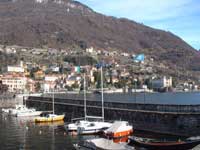 |
|
| Gravedona, characterised by its gorgeous promenade, constitutes one of the greatest attractions of the northern part of the Como Lake. Alongside with its large number of shops and restaurants, Gravedona is rich of art and history: the church of St. Maria del Tiglio (11th century) one of the most significant Romanesque monuments of the northern part of the Lario; the parish church of St. Vincenzo (12th century) and the sumptuous Palazzo Galio, built at the end of the 16th century. Gravedona is the ideal point of departure to visit all the villages of the area: Dongo with its gorgeous square looking out onto the lake and the church of St. Stefano; Musso, a small characteristic village extending on the flanks of the mountains, famous all over the world for its yard Lillia, that, thanks to its Star class sailing boat team, won several Olympic medals; and Sainta Maria Rezzonico and Acquaseria: ancient villages of rare beauty. | ||
| Bellagio | 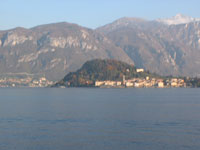 |
|
|
Also
known as "The Pearl of the Lario", Bellagio is one of the most important
destinations for all tourists eager to visit the beautiful shores of the
Como lake. Many movie stars and famous historical VIP's of the past such
as J.F.Kennedy, Stendhal and Liszt had a stroll under the arcades of Piazza
Mazzini. The garden and the museum of Villa Melzi, Villa Trotti, Villa
Giulia, Villa Serbelloni (property of the Rockfeller Foundation organising
different conferences and courses here) and the characteristic small harbour
of Loppia are only a few of the several treasures charming tourists walking
down the characteristic streets and the wonderful stairs constituting
the central part of Bellagio. Art, architecture and natural beauties are
the peculiarities of this small town rising on a peninsula right in the
middle of the Como lake.
|
||
| Varenna | 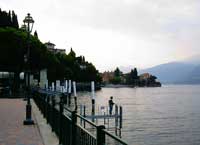 |
|
| Varenna, a gorgeous old village developing across the mountains of the Lario lake, is one of the more picturesque attractions of the Como lake. You cannot but visit the Castle of Vezio, built in 1300 and recently restored. The castle, rising on a cape, looks down onto the lake. Do not forget Villa Monastero, (built in 1200) rich of historical and artistic attractions and rising in the heart of a beautiful garden extended throughout the years along the flanks of the surrounding mountains. And what about Villa Cipressi? At present it is a prolific centre for courses and conferences. Let's not forget the Church of St. George dating back to 1313 and restored in the 19th century. | ||
| Como | 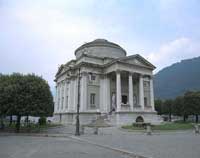 |
|
| Como, one of the most important Italian cities, is renowned for being a thriving commercial and industrial centre, especially as far as silk manufacturing and fashion are concerned. Founded by the Romans, the city is rich of several historical and artistic testimonies: the 18th-century Dome, whose construction began in the 1396, the 13th-century "Broletto", the old town hall; the Basilica of St. Fedele (6th century) and the Romanesque church of St. Abbondio (14th century); the Castle of Baradello built under the rule of Federico Barbarossa (12th century), the Tempio Voltiano (1927), the Terragni palace (1932-36), "Il Sociale" Theatre (1811-13), not to mention the many museums (the local picture gallery: "pinacoteca civica", the silk museum, the archaeological civic museum and the museum of the "Rinascimento"). Do not to miss the gorgeous villas rising on the shores of the Lario (Villa Olmo, Villa Geno etc). | ||
| Lugano | 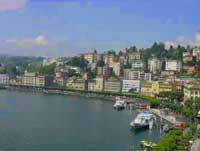 |
|
| Tourists visiting the Insubrica region cannot absolutely miss the town of Lugano mainly renowned for being a thriving financial centre. Walking down the streets and squares in the town centre you will come across many important and beautiful historical and architectural monuments. Alongside with the canton museum of art and the museum of modern art, Lugano is rich of magnificent churches and palazzos: the cathedral of St. Lorenzo (875), the church of St. George (1618), the church of St. Rocco (1349), the Palazzo Civico with its magnificent statues (1844), the St. Carlino designed by the famous architect Mario Botta, Villa Favorita rising right under the Brč mount and, of course, Villa Ciani housing the town museum of Fine Arts. | ||
| Campione d'Italia | 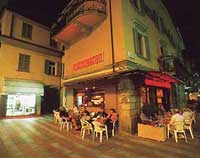 |
|
| CCampione, an Italian enclave in Swiss territory, rises on the Ceresio lake shore, exactly in the middle between Como and Lugano. This is the ideal place to spend a relaxing day walking along the promenade on the lake or having a stroll down its typical old narrow streets. Against this charming background, art and history go hand in hand with refined jet-set and night entertainment: the Municipal Casino, inaugurated in 1933, offers many attractions, concerts and international shows. Many VIP's performed in the Salone delle Feste (The main hall) of the casino: Liza Minelli, Juliette Greco, B.B.King, Ray Charles, etc. | ||
|
For further information watch out the following sites: Azienda provinciale del turismo di Como Azienda di promozione del turismo in Ticino |
||
_______________________________________________________________________________________________
